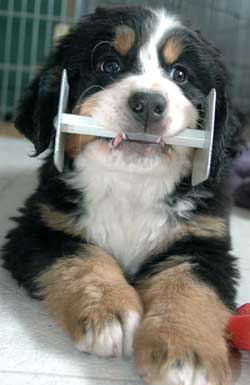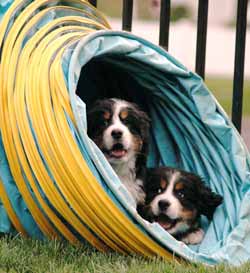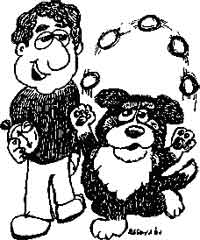Games Performance Puppies Can Play
By Brenda Sanders
Originally published in The BMDCA's Newsletter, 'The Alpenhorn', February 2006.
 You recently or soon will add a new puppy to your life! This new little soul is going to be your first (or next) star in obedience, drafting, agility, or rally. But it's such a long wait until Star is 2 and physically ready for the demands of real training. Is there something more than puppy kindergarten class you can do if performance is your goal? Yes!!! Teaching a puppy words is a very easy and fun game and can reap huge rewards later on. Remember that your puppy is constantly learning, whether you think you are teaching or not!
You recently or soon will add a new puppy to your life! This new little soul is going to be your first (or next) star in obedience, drafting, agility, or rally. But it's such a long wait until Star is 2 and physically ready for the demands of real training. Is there something more than puppy kindergarten class you can do if performance is your goal? Yes!!! Teaching a puppy words is a very easy and fun game and can reap huge rewards later on. Remember that your puppy is constantly learning, whether you think you are teaching or not!
For the first week or so, Star will have quite a lot on her mind: moving to a new home, learning where to go potty, meeting other dogs and people in the household, adjusting to the new routine. "Training" at this stage may not be very effective. But that does not mean you shouldn't be watching and learning.
Observe your puppy. Learn her rhythms. Is she all fired up in the morning, or does an energy burst come just when you settle in front the TV (or both)? You will want to take advantage of her up times for teaching. Observe her reactions to other people and dogs. How soft or confident is she? These reactions are clues to you on how you will have to handle mistakes in the future. Does she startle and how much at loud noises? Or a car passing? Or a paper blowing across the yard? These are clues to her level of sound and sight sensitivity and will allow you to anticipate later problems. Watch for behaviors Star offers on her own. Does she bark when she goes to the door? Does she sit in front of you when you're fixing her meals? Does she put a paw on you when you sit in your chair? These behaviors will become "speak," "front," and "shake" that you will train.
Once you have identified several behaviors that Star does on her own, it is time to teach her words. Always have treats in your pockets or nearby in every area of the house where Star is with you. You are fixing her dinner. When she sits in front, you say, "front, good front," and treat. Every time she sits in front of you for a few days, name and reward. After a few days, when she barks at the door, you say, "speak, good speak," and treat. In another few days, name and reward "shake" when she puts a paw on you. Most puppies will, by the end of a week, be rushing to perform the behaviors and get the reward. They are catching on that certain words mean a reward. (You can also use a clicker instead of the word. I'm not coordinated enough to handle something else in my hands!) When you see this reaction, you are ready to move on.
The next step is to ask for one of these behaviors immediately before Star performs it. You will have to be quick! Right before she sits, you say, "front." When she does, repeat "front, good front" and treat. Rather than just receiving a reward for something she does, Star has just been rewarded for a response to a word from you. Practice with all three of the words you chose.
When you are sure Star knows the three words and is performing them when asked, the next step is to ask for the behavior in a different context. You're standing at the desk, reading your mail, and Star is with you. Ask her to "front." If she does, "front, good front" and treat. Now she knows the word in a context other than mealtime. (If she doesn't front, continue the previous step for a few more days). Ask for all three behaviors in different situations. When you're getting a reliable response to all three, you're ready for the next step.
You will need Star's absolute favorite treat and another one that is good, but not the high value of the first one. Example from my house: buffalo jerky is the best ever; string cheese is good, but it is not jerky! Make sure Star knows jerky is available. You've taught her "speak" at the door, and she does it reliably in other locations. Now go to the door and ask for "front." Almost surely Star will "speak." You respond, "speak, good speak," and reward with cheese. Ask for "front." If Star speaks again, reward with cheese. She will be very puzzled at this point, wondering why she isn't getting the jerky she knows you have! On the third try, ask for "speak," and name and reward with jerky so she knows it is possible to get the best reward. Then return to asking for "front." Try to not laugh as you watch puppy brain try to figure out how to get that jerky! Why do I do this exercise? I want my dogs to be unafraid of making mistakes. You've all seen dogs in Utility that bring back the wrong article, or in agility that get called back to repeat an obstacle, and just shut down. They can't handle making mistakes. I try to teach my puppy, "Ok, good try. Here's a little reward for the try, but let's try again for the big reward. A mistake is no big deal; we just have to try again." Eventually, of course, you will stop rewarding incorrect behaviors, but Star is a baby, and now you want to teach that learning is fun.
Begin combining behaviors. Ask for "speak" then "shake" before rewarding. Then "shake," "speak," "front" before rewarding. These brain exercises can and should be worked many times a day rather than in one concentrated session.
Once Star understands the concept that different words have different meanings, you can work on increasing her vocabulary. Give names to her toys. Begin with two or three: "Pinkie" "Bear" "Spider." Later, you can use "find metal" and "find leather" when teaching scent articles. In agility, "teeter" "tunnel" "A frame" will all have associations. You are limited only by your imagination. Does Star follow you into the bathroom or the walk-in closet? Teach "back" as the way to get out. When you need to back up your cart or perform Back Up 3 Steps in Rally, you will have laid the foundation at 3 or 4 months of age. I have even taught both of my dogs "new word" to cue them that 1 am asking them to learn something different!
In addition to training the brain, you can do many things to train the body as well, and most are probably familiar to you. Lay different surfaces on the floor or in the yard (a piece of cardboard, a tarp, some hardware cloth) so Star can practice walking on different surfaces. Use ground poles or a ladder on the ground so she can learn how to place her rear feet.
 Utility go-outs are a great puppy exercise. Place a treat on a target 6 to 8 feet in front of Star and send her to it. If you need to increase drive, have someone restrain her or put her in a crate and really rile her up before you let her go. Gradually increase the distance you are sending her. Teach agility lateral send-outs by using a sturdy garbage can or some other barrier (a kitchen island works great). Place the treat on the target on the left side of the barrier, approach with Star from the right side, and send her left to the target while you run by the right side and call her to you on the far side of the barrier. "Follow my hand" exercises can teach turn with, turn away, switch sides, cross behind, all of which become the foundation for many agility and rally moves. Teach these and lateral sends from both left and right sides if your goal is agility. Most puppies love tunnels or can quickly learn to enjoy them. Have another person restrain Star at the tunnel entrance while you go to the opposite end and call her. Don't always gather her up as soon as she gets out of the tunnel or she may learn to not drive on to the next obstacle. Instead, run past the tunnel and teach her to come to the hand with the treat.
Utility go-outs are a great puppy exercise. Place a treat on a target 6 to 8 feet in front of Star and send her to it. If you need to increase drive, have someone restrain her or put her in a crate and really rile her up before you let her go. Gradually increase the distance you are sending her. Teach agility lateral send-outs by using a sturdy garbage can or some other barrier (a kitchen island works great). Place the treat on the target on the left side of the barrier, approach with Star from the right side, and send her left to the target while you run by the right side and call her to you on the far side of the barrier. "Follow my hand" exercises can teach turn with, turn away, switch sides, cross behind, all of which become the foundation for many agility and rally moves. Teach these and lateral sends from both left and right sides if your goal is agility. Most puppies love tunnels or can quickly learn to enjoy them. Have another person restrain Star at the tunnel entrance while you go to the opposite end and call her. Don't always gather her up as soon as she gets out of the tunnel or she may learn to not drive on to the next obstacle. Instead, run past the tunnel and teach her to come to the hand with the treat.
Should you take Star to puppy classes? If you have a good puppy agility class in your area, I would say absolutely yes, even if agility is not in your future plans. A good puppy agility class focuses on socialization, controlled walking, following hand movements, walking up and down baby-sized ramps, tunnels, the table and box (UKC obstacle), ground poles, sit, stay, recalls, and others. The class I attend runs for 16 weeks, and jumps are limited to cavaletti style in the last 4 sessions and are never more than 4 to 8 inches high. I personally would not attend a puppy agility class that puts a lot of emphasis on jumping and weave poles or starts with obstacles at full height. An appropriate class is a wonderful confidence booster no matter what your future goals. Always observe some classes before you sign up, and note what is being emphasized.
If you don't have access to a puppy agility class, it is somewhat easier to find puppy kindergartens. Again, if you have a good one available by all means use it. But even a not-so-good class can be useful to you.  I would absolutely avoid any class that uses harsh physical corrections with puppies or relies on alpha rolls. What if there are some good and some not so good things about the classes available to you? Talk with the instructor if possible before signing up, and ask whether you may choose to not participate in some aspects of the class. If the class spends a lot of time heeling in circles with jerk and release corrections, find a corner or go out to the middle of the floor and work on your 2 to 3 steps of attentive heeling with Star. If the instructor is doing the stand for exam with each puppy and everyone else is just standing around waiting, practice sits or fronts with Star while waiting your turn. If the instructor is holding puppies down and forcibly trimming their nails, just say you don't need help with that. (You have been trimming nails since Star came home, right, even if it's just one nail per day?)
I would absolutely avoid any class that uses harsh physical corrections with puppies or relies on alpha rolls. What if there are some good and some not so good things about the classes available to you? Talk with the instructor if possible before signing up, and ask whether you may choose to not participate in some aspects of the class. If the class spends a lot of time heeling in circles with jerk and release corrections, find a corner or go out to the middle of the floor and work on your 2 to 3 steps of attentive heeling with Star. If the instructor is doing the stand for exam with each puppy and everyone else is just standing around waiting, practice sits or fronts with Star while waiting your turn. If the instructor is holding puppies down and forcibly trimming their nails, just say you don't need help with that. (You have been trimming nails since Star came home, right, even if it's just one nail per day?)
I was recently in a class where the puppies were asked to do a recall from halfway across the room between two rows of motion-activated toys that moved, lit up, and made noise. If the toys had been gradually introduced one at a time while the puppies were heeling, that might have been appropriate, but in this situation I politely told the instructor my puppy wasn't ready for this exercise, and we didn't participate. You need to know what is appropriate for you and Star, but the chance to work in a new location with other dogs and people is an important opportunity. Remember that the instructor is in charge of the class, but only you are in charge of you relationship with Star. Know your puppy and what she can handle, make learning fun, and enjoy that new puppy! The time passes all too quickly.
Brenda Sanders lives in Rockton Illinois. Her first Bernese Mountain dog, who joined her in 1985, managed to train Brenda well enough to earn 10 titles. Five Bernese since then have earned 45 titles through CDX, AXP, and UACHX, as well as a TDX, two conformation championships, and two therapy dog certifications. Currently, Brenda lives with two Berners, both of whom compete in agility and rally obedience.